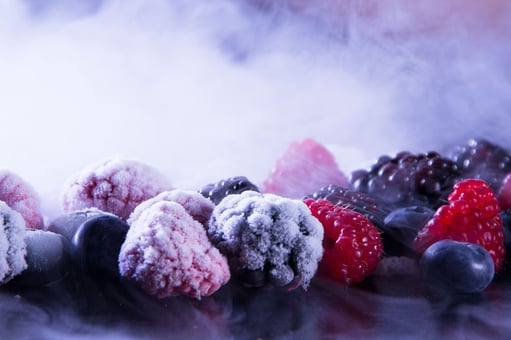Cut down on food wastage during your Eid celebrations by embracing your freezer. You’ll have perfectly edible treats to eat for weeks to come.
After cooking fresh foods everyday and after indulging in even more food during Eid, you might be looking forward to a break from cooking. You may also find your fridge, pantry and kitchen overflowing with left over vegetables, fruits and cooked dishes.
Set aside some time to tackle your pile of food and to prevent it from going bad. Decide on what you can use in the next few days and what you need to freeze for later. Here’s a how-to guide to help you freeze the ‘right’ way.
Freeze foods sooner rather than later.
Contrary to popular belief, you shouldn’t just toss left overs in the freezer after your meal is over. After all, this food has probably been sitting out for a few hours. The food that goes into the freezer should be of the best quality possible, so that the food that comes out retains its taste and texture.
Consider keeping left over cooked meals in the fridge to consume within the next 2-3 days. If you are cooking an extra portion, cool it quickly and freeze immediately after, in order to prevent growth of bacteria.
You can do this by 'shallow cooling' foods in the refrigerator. Place your hot food in a wide container so that the food forms a relatively thin layer (about an inch high) and cover loosely. Once cool, move it to the freezer. This process prevents the formation of ‘freezer burn’ or ice crystals on the food.
Freezer burn also occurs when frozen food comes in contact with air. This is why its important to freeze meals in smaller portions, so that you only need to thaw the amount you need and not the entire dish.
Food that can be frozen

Photo by Devin Rajaram on Unsplash
Here’s a list of foods that do well in the freezer, and some tips to make sure they stay good.
- Berries – think raspberries, blackberries, strawberries and blueberries, yum!
- Sliced apples – these can be used in baking as soon as you remove them from the freezer.
- Bananas – freeze them without peels and possibly in slices, depending on how you plan to use them later. Use the banana immediately after removing from the freezer because it will go mushy very soon.
- Herbs – chop extra herbs and freeze in ice cubes with water. Use them in cooking, as they will be too soft and wet for garnishing.
- Breads – breads don’t fare well outside in the UAE summer, but do surprisingly well in the freezer. Try freezing different kinds of breads to gauge which freeze well for you, and enjoy them toasted.
- Vegetables – chop and blanch vegetables. That is, bring them to a boil before quickly cooling in icy cold water, draining, patting dry and freezing. This will ensure they don’t go brown and will help retain their flavour and texture.
Vegetables like beans, carrots, broccoli, cauliflower, eggplant, brussel sprouts, beets, corn, peas, soya bean, sweet potatoes, tomatoes, zucchini and onions can be frozen.
Greens like spinach and kale can be frozen without blanching and used in smoothies or in cooking.
- Vegetable scraps (like onion peels and small leftover bits) – collect veggie scraps in a designated ‘veggie scrap’ container in the freezer. When you have enough scraps and enough time, use them to make a nutritious broth.
- Sauces and soups – these freeze well, as long as they do not contain thickening agents (like corn flour) or emulsified oils.
Top tip: freeze fruits individually to avoid them bunching together.
Individual quick freezing works especially well for strawberries. Line up the fruit on a tray and keep in the freezer for around two hours. Once frozen, collect them together and store in a container. This will prevent the fruit from sticking together, and will ensure you can use them in more than just smoothies.
You can freeze vegetables individually as well.
Avoid freezing these foods...
- Fresh raw vegetables will lose colour and texture. It’s better to blanch, if you want to retain some crunch.
- Vegetables and fruits with high water content will lose their crunchy texture and become mush – avoid freezing lettuce, cucumber, bean sprouts, radish and watermelon.
- Dairy products like yogurt, sour cream and soft cheeses will separate in the freezer.
- Oil-based sauces or salad dressings, like mayonnaise, will separate as well and lose texture.
- Soups or sauces with thickeners will separate and become lumpy. Instead, add the thickeners after removing from the freezer.
Store in thick, reusable freezer bags
Reusable tupperware may take up too much space, depending on how much you have to freeze and the size of your freezer. Glass containers may crack as foods expand in the freezer, especially in the case of liquids.
Freezer bags are popular because they are thicker than normal zip lock bags, last longer, are reusable for the most part and can be stacked vertically to save space. You can even opt for a silicone reusable freezer bag, to avoid your food coming in contact with plastic.
Make sure to wrap foods tightly and remove any air while freezing to avoid freezer burn.
Ready, set, freeze!
Now that you know the basics, go ahead and get started. Clear out your freezer, line up your containers or bags and save your extra food from the bin (here’s why it’s so beneficial for the planet).
Stack your foods in a way that looks nice, so that you will feel like eating it later. Show off your hard work on Instagram with #ZeroWaste #YallaGreen and tag us @ews-wwf @moccaeuae @dubaicarbon, @thesustainabilistme & @winnowsolutions






